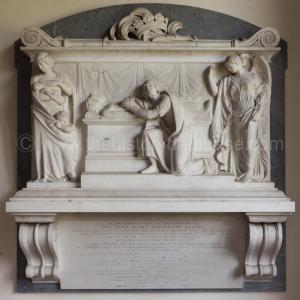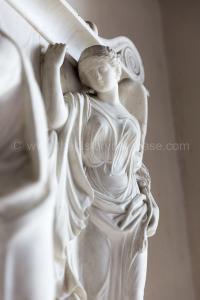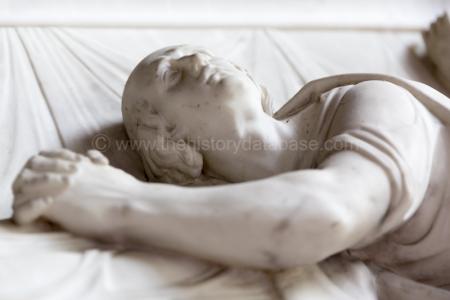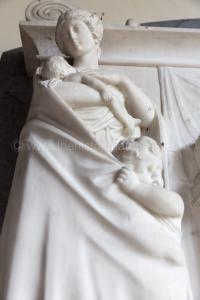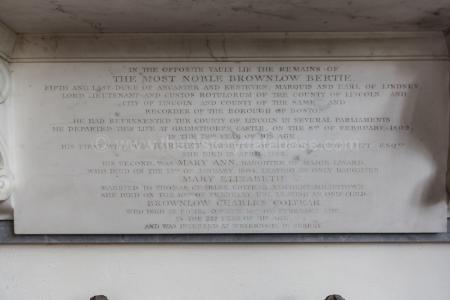Cornice
Cornice is in Architectural Detail.
On 25 Aug 1282 Bishop Thomas Cantilupe (age 64) died in Ferento, Orvieto. Monument in the North Transept of Hereford Cathedral [Map] in the form of a shrine-pedestal and consisting of an altar-tomb and open superstructure (Plate 134), altar-tomb possibly slightly earlier than the rest, tapering on plan and re-assembled, long sides with six bays and W. end with two bays of cinque-foiled arcading on attached shafts with foliated capitals and moulded bases, spandrels carved with varying naturalistic foliage; each bay filled with figure of knight (Plate 136) with long surcoat, heater-shaped shield and feet on lions and other beasts, faces all defaced; on slab, indent of brass figure of bishop with mitre and crozier and canopy; small brass figure of St. Ethelbert now in library; superstructure with six bays on long sides and two at W. end of open trefoiled arcading resting on shafts with moulded capitals and bases, spandrels carved with naturalistic foliage and winged beasts, moulded cornice at top and plain top slab; E. end of tomb, plain and not intended to be seen, with part of carved spandrel set in it.
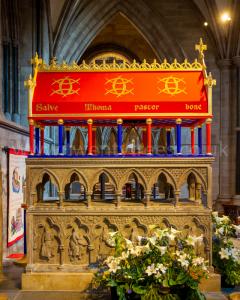
After 10 Aug 1358. Monument to Piers Grandison 2nd Baron Grandison. Lady Chapel of Hereford Cathedral [Map]. Mid 14th-century, altar-tomb with effigy and canopy, altar-tomb with range of cinquefoil-headed panels in front and panelled buttresses at ends carried up to the cornice of the canopy, effigy in mixed mail and plate-armour with camail and ridged bascinet, hauberk with scalloped lower edge, cyclas, enriched Hip Belt with dagger hanging in front and sword at side, head on cushions and feet on hound; recess with panelled back, moulded jambs and square head enriched with Paterae and trefoiled and sub-cusped pendant tracery below the head; vaulted soffit to canopy; canopy with range of six bays of open arcading with trefoiled and sub-cusped heads, crockets and finials, in arcading two headless figures of the Coronation of the Virgin, headless figure with book, archbishop with cross-staff, St. John the Baptist holding a roundel with the Agnus Dei, and a bishop, last four figures brought from elsewhere; canopy finished with enriched cornice and pierced parapet with quatrefoils and cusped cresting.
Piers Grandison 2nd Baron Grandison: he was born to William Grandison 1st Baron Grandison and Sibylla Tregoz Baroness Grandison at Ashperton, Ledbury. On 27 Jun 1335 William Grandison 1st Baron Grandison died at Lambourne, Berkshire. His son Piers Grandison 2nd Baron Grandison succeeded 2nd Baron Grandison. Blanche Mortimer Baroness Grandison by marriage Baroness Grandison. In or before 1340 Piers Grandison 2nd Baron Grandison and Blanche Mortimer Baroness Grandison were married. She the daughter of Roger Mortimer 1st Earl March and Joan Geneville Baroness Mortimer 2nd Baroness Geneville. She a great x 4 granddaughter of King John "Lackland" of England. On 10 Aug 1358 Piers Grandison 2nd Baron Grandison died at Ashperton, Ledbury. His brother Bishop John Grandison 3rd Baron Grandison succeeded 3rd Baron Grandison.
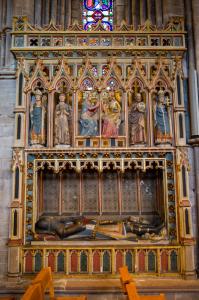
In 1435 Richard Delamere died, and Isabel his wife, died 1421. Monument in the North Transept of Hereford Cathedral [Map]. Figure of man in plate armour, feet on lion, figure of lady in horned headdress and SS collar, two dogs at feet, double canopy with cinque-foiled and sub-cusped arches and crocketted ogee gables and upper cornice, parts of standards and pinnacles missing, foot inscription and three shields-of-arms (a) Delamere, (b) the same impaling Acton.
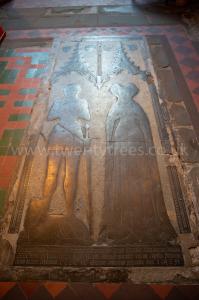
After 19 Mar 1553. St Martin's Church, Stamford [Map]. Monument to Richard Cecil (deceased) and his wife Jane Heckington. Kneeling figures under an elaborate cornice. Attributed to Cornelius Cure. Elizabethan Period.
Jane Heckington: she was born to William Heckington. Before 1520 Richard Cecil and she were married. On 10 Mar 1587 she died.
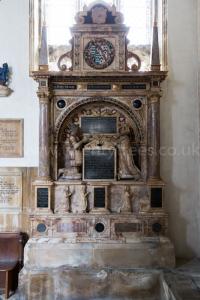
On 19 Sep 1580 Catherine Willoughby Duchess Suffolk (age 61) died. Her son Peregrine Bertie 13th Baron Willoughby (age 24) succeeded 13th Baron Willoughby de Eresby. Mary Vere Baroness Willoughby of Eresby by marriage Baroness Willoughby de Eresby.


She was buried at St James' Church, Spilsby [Map] with her second husband Richard Bertie Baron Willoughby (age 63). Elizabethan Period. Sideboard Tomb. Cornice supported by three figures of a monk and two wildmen, each holding aloft a shield of arms. In the frieze are flowers, fruit and escutcheons.
Mary Vere Baroness Willoughby of Eresby: she was born to John de Vere 16th Earl of Oxford and Margery Golding Countess of Oxford. On 25 Dec 1577 Peregrine Bertie 13th Baron Willoughby and she were married. She the daughter of John de Vere 16th Earl of Oxford and Margery Golding Countess of Oxford. He the son of Richard Bertie Baron Willoughby and Catherine Willoughby Duchess Suffolk. Around 24 Jun 1624 Mary Vere Baroness Willoughby of Eresby died.
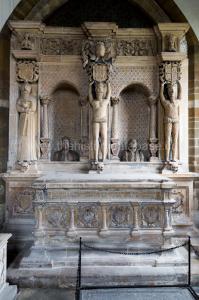
In or after 1582. Memorial to Elizabeth Gurdon 1565-1582 who, apparently died of a cold whilst visiting Edward Clere (age 45). Semicircular niche with leaf spandrels and modillion cornice on Ionic colonnettes containing a kneeling figure at St Andrew's Church, Blickling [Map].
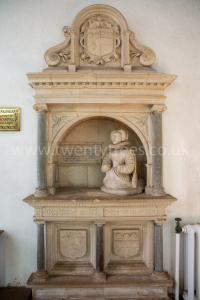
On 11 Sep 1617 Anthony Mildmay (age 68) died. He was buried at the Church of St Leonard, Apethorpe [Map]. His inscription reads ... Here sleepeth in the Lord with certaine hope of resurection Sr Antony Mildmay Knt eldet sonne to Sr Walter Mildmay Knt Chaunclor of the Exchequor. to Queene Elizabeth. He was Embassador from Queen Eliza: to the most Christian King of Fraunce Henry the 4th Ano. 1596; He was to Prince and Country faithful, and serviceable, in peace and warre, to freinds constant to enemies reconciliable. Bountiful and loved hospitality. He died September 11 1617.
On 27 Jul 1620 Grace Sharington (age 68) died. She was buried at the Church of St Leonard, Apethorpe [Map]. The inscription of her monument reads ... Here also lyeth Grace Ladie Mildmay the only wife of the saied Sr Antho: Mildmay one of the heyres of Sr Henry Sharington Knt: of Lacock in the County of Wiltes who lived 50 years maried to him and three years a widow after him. she was most devout, unspotedly chast mayd, wife, and widow, compassionate in heart, and charitably helpful with phisick, cloathes, nourishment, or counsels to any in misery, She was most careful and wise in managing worldly estate. So as her life was a blessing to hirs, and hir death she blessed them which hapned July 27 1620.
From RCHME Inventory. It is of grey veined and black marble and is partly gilded and painted. Two effigies lie on a black and white marble tomb chest beneath a baldachino consisting of a shallow dome with a cupola having round-headed openings in its drum, which give light to the interior. The baldachino is supported at each end by a rectangular pier onto which curtains, hanging from the architrave of the dome, are looped. Against the piers are standing figures representing the four Virtues, and the frieze is inscribed 'Devoute', 'Wise', 'Charitable' and 'Just'; the frieze is also inscribed 'Chaste' and 'Valiant'. The head of the figure representing Justice is modern. Seated on the cornice are smaller figures, on the E. of Faith and on the W. of Hope; on the cupola dome is a seated figure of Charity. Crowning the cornice are freestanding cartouches of arms of Mildmay (N.E. and S.E.) and Sherington (N.W. and S.W.). Against the cupola drum are shields of arms of Mildmay impaling Sherington, both quartered with alliances, and Mildmay quarterly. The W. pier of the baldachino is inscribed with a record of the setting up of the monument by Sir Francis Fane (age 37) in 1621. The tomb chest is enriched with emblems of mortality and eulogistically-phrased inscriptions record the lives of Sir Anthony on the S., and of Lady Grace on the N. The effigies lie on rush mats, he in Greenwich armour, she in full mantle, ruff and head-dress. The authorship of the monument is not known but the figures of the four Virtues are in the manner of Maximillian Colt (age 42) (cf. Cecil monument, Hatfield, Hertfordshire); the baldachino may be compared with that over the tomb of the Countess of Derby at Harefield, Middlesex, probably also by Colt (age 42).
Grace Sharington: Around 1552 she was born to Henry Sharington of Lacock in Wiltshire and Anne Paggett of Lacock Abbey. In 1567 Anthony Mildmay and she were married. They lived at Apethorpe Hall, Northamptonshire. In 1581 Henry Sharington of Lacock in Wiltshire died. His two surviving daughters for many disputed his will. According to Grace Sharington her sister Olive Sharington had persuaded their father to change his will. Grace Sharington eventually gained an equal share.
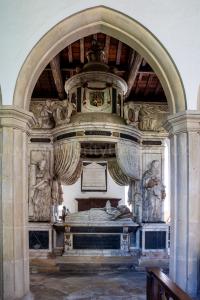
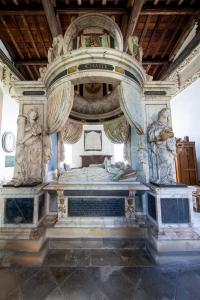
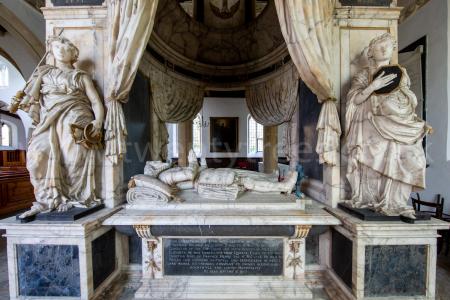
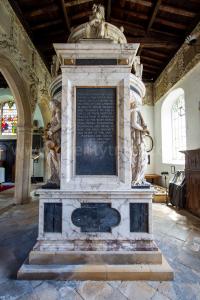
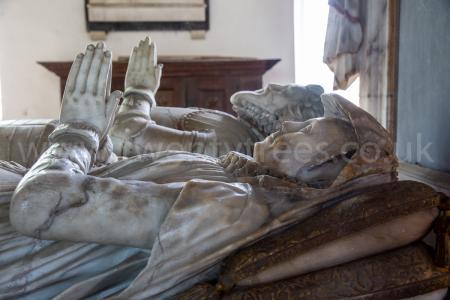
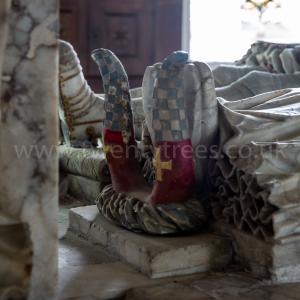
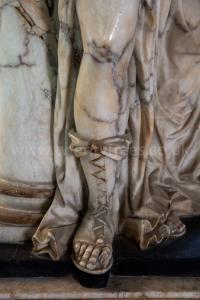
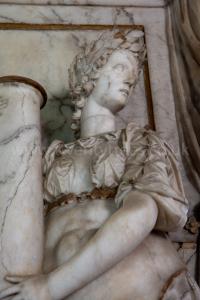

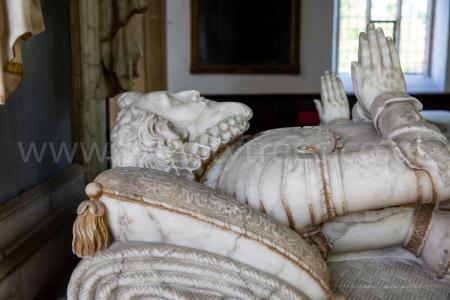
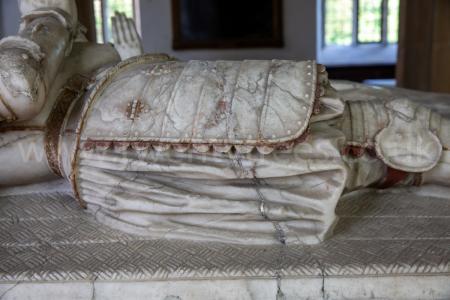
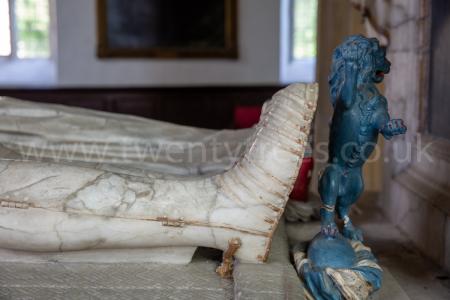
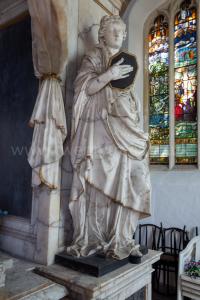
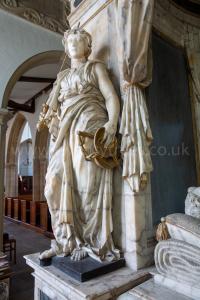
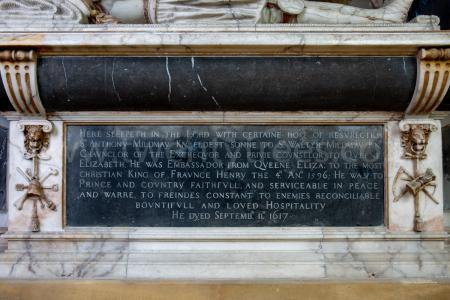
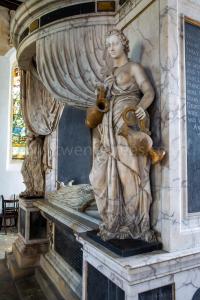
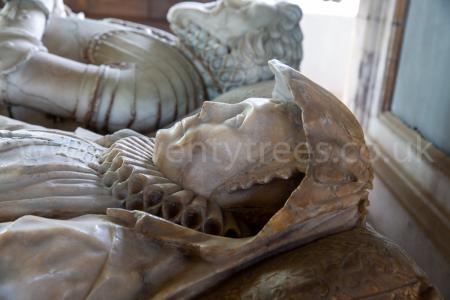
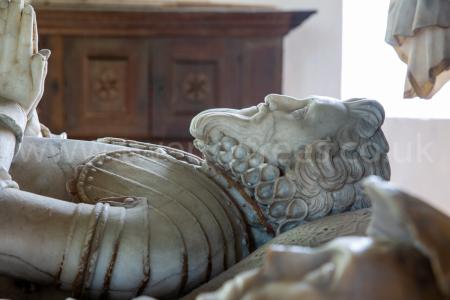
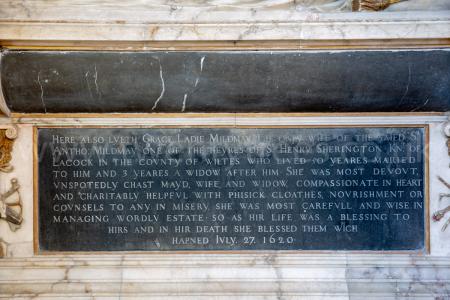
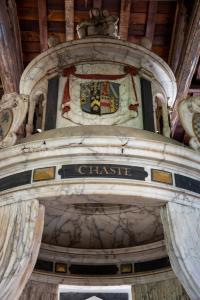
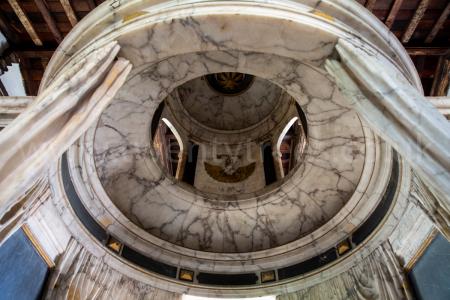
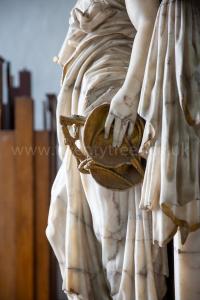
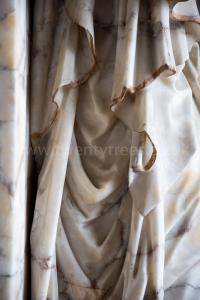
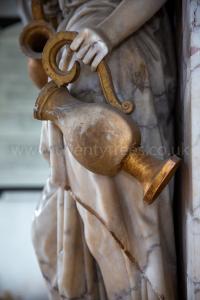
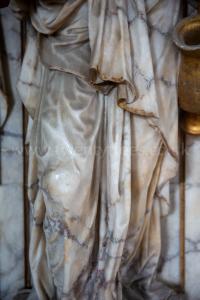
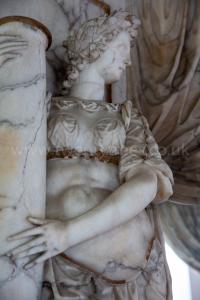
Evelyn's Diary. 08 Feb 1644. The next day, I went to see the Louvre with more attention, its several courts and pavilions. One of the quadrangles, begun by Henry IV., and finished by his son and grandson, is a superb, but mixed structure. The cornices, moldings, and compartments, with the insertion of several colored marbles, have been of great expense.
Evelyn's Diary. 25 Oct 1644. Not far from hence is the Church and Convent of the Dominicans, where in the chapel of St. Catherine of Sienna they show her head, the rest of her body being translated to Rome. The Duomo, or Cathedral, both without and within, is of large square stones of black and white marble polished, of inexpressible beauty, as is the front adorned with sculpture and rare statues. In the middle is a stately cupola and two columns of sundry streaked colored marble. About the body of the church, on a cornice within, are inserted the heads of all the Popes. The pulpit is beautified with marble figures, a piece of exquisite work; but what exceeds all description is the pavement, where (besides the various emblems and other figures in the nave) the choir is wrought with the history of the Bible, so artificially expressed in the natural colors of the marbles, that few pictures exceed it. Here stands a Christo, rarely cut in marble, and on the large high altar is a brazen vessel of admirable invention and art. The organs are exceeding sweet and well tuned. On the left side of the altar is the library, where are painted the acts of Æneas Sylvius, and others by Raphael. They showed us an arm of St. John the Baptist, wherewith, they say, he baptized our Savior in Jordan; it was given by the King of Peloponnesus to one of the Popes, as an inscription testifies. They have also St. Peter's sword, with which he smote off the ear of Malchus.
Evelyn's Diary. 17 Nov 1644. I walked to Villa Borghese, a house and ample garden on Mons Pincius, yet somewhat without the city walls, circumscribed by another wall full of small turrets and banqueting-houses; which makes it appear at a distance like a little town. Within it is an elysium of delight, having in the centre of it a noble palace; but the entrance of the garden presents us with a very glorious fabric, or rather door-case, adorned with divers excellent marble statues. This garden abounded with all sorts of delicious fruit and exotic simples, fountains of sundry inventions, groves, and small rivulets. There is also adjoining to it a vivarium for ostriches, peacocks, swans, cranes, etc., and divers strange beasts, deer, and hares. The grotto is very rare, and represents, among other devices, artificial rain, and sundry shapes of vessels, flowers, etc.; which is effected by changing the heads of the fountains. The groves are of cypress, laurel, pine, myrtle, and olive. The four sphinxes are very antique, and worthy observation. To this is a volary, full of curious birds. The house is square with turrets, from which the prospect is excellent toward Rome, and the environing hills, covered as they now are with snow, which indeed commonly continues even a great part of the summer, affording sweet refreshment. Round the house is a baluster of white marble, with frequent jettos of water, and adorned with a multitude of statues. The walls of the house are covered with antique incrustations of history, as that of Curtius, the Rape of Europa, Leda, etc. The cornices above consist of fruitages and festoons, between which are niches furnished with statues, which order is observed to the very roof. In the lodge, at the entry, are divers good statues of Consuls, etc., with two pieces of field artillery upon carriages, (a mode much practiced in Italy before the great men's houses) which they look on as a piece of state more than defense. In the first hall within, are the twelve Roman Emperors, of excellent marble; between them stand porphyry columns, and other precious stones of vast height and magnitude, with urns of oriental alabaster. Tables of pietra-commessa: and here is that renowned Diana which Pompey worshiped, of eastern marble: the most incomparable Seneca of touch, bleeding in an huge vase of porphyry, resembling the drops of his blood; the so famous Gladiator, and the Hermaphrodite upon a quilt of stone. The new piece of Daphne, and David, of Cavaliero Bernini, is observable for the pure whiteness of the stone, and the art of the statuary plainly stupendous. There is a multitude of rare pictures of infinite value, by the best masters; huge tables of porphyry, and two exquisitely wrought vases of the same. In another chamber, are divers sorts of instruments of music: among other toys that of a satyr, which so artificially expressed a human voice, with the motion of eyes and head, that it might easily afright one who was not prepared for that most extravagant sight. They showed us also a chair that catches fast any one who sits down in it, so as not to be able to stir out, by certain springs concealed in the arms and back thereof, which at sitting down surprises a man on the sudden, locking him in by the arms and thighs, after a true treacherous Italian guise. The perspective is also considerable, composed by the position of looking-glasses, which render a strange multiplication of things resembling divers most richly furnished rooms. Here stands a rare clock of German work; in a word, nothing but what is magnificent is to be seen in this Paradise.
Evelyn's Diary. 28 Jan 1645. The day following, we were fain to hire a strong convoy of about thirty firelocks, to guard us through the cork woods (much infested with the banditti) as far as Fossa Nuova, where was the Forum Appii, and now stands a church with a great monastery, the place where Thomas Aquinas both studied and lies buried. Here we all alighted, and were most courteously received by the Monks, who showed us many relics of their learned Saint and at the high altar the print forsooth of the mule's hoof which he caused to kneel before the Host. The church is old, built after the Gothic manner; but the place is very agreeably melancholy. After this, pursuing the same noble [Appian] way (which we had before left a little), we found it to stretch from Capua to Rome itself, and afterward as far as Brundusium. It was built by that famous Consul, twenty-five feet broad, every twelve feet something ascending for the ease and firmer footing of horse and man; both the sides are also a little raised for those who travel on foot. The whole is paved with a kind of beach-stone, and, as I said, ever and anon adorned with some old ruin, sepulchre, or broken statue. In one of these monuments Pancirollus tells us that, in the time of Paul III., there was found the body of a young lady, swimming in a kind of bath of precious oil, or liquor, fresh and entire as if she had been living, neither her face discolored, nor her hair disordered; at her feet burnt a lamp, which suddenly expired at the opening of the vault; having flamed, as was computed, now 1,500 years, by the conjecture that she was Tulliola, the daughter of Cicero, whose body was thus found, and as the inscription testified. We dined this day at Terracina, heretofore the famous Anxur, which stands upon a very eminent promontory, the Circean by name. While meat was preparing, I went up into the town, and viewed the fair remainders of Jupiter's Temple, now converted into a church, adorned with most stately columns; its architecture has been excellent, as may be deduced from the goodly cornices, moldings, and huge white marbles of which it is built. Before the portico stands a pillar thus inscribed: Inclyta Gothorum Regis monumenta vetusta Anxuri hoc Oculos exposuere loco;.
Evelyn's Diary. 06 May 1645. Having gratified our curiosity with these artificial miracles, and dined, we went to see the so famous natural precipice and cascade of the river Anio, rushing down from the mountains of Tivoli with that fury that, what with the mist it perpetually casts up by the breaking of the water against the rocks, and what with the sun shining on it and forming a natural Iris, and the prodigious depth of the gulf below, it is enough to astonish one that looks on it. Upon the summit of this rock stands the ruins and some pillars and cornices of the Temple of Sibylla Tyburtina, or Albunea, a round fabric, still discovering some of its pristine beauty. Here was a great deal of gunpowder drying in the sun, and a little beneath, mills belonging to the Pope.
After 25 Jul 1666. Church of St Michael and All Angels, Edenham [Map]. Monument to Montagu Bertie 2nd Earl Lindsey (deceased). Two adjacent memorial tablets have moulded base and cornice and are surmounted by the Cartouche of arms and the Ancaster cannon. To the sides are military trophies in high relief and at the base, arms, anchors and helms.[Source: BLB].
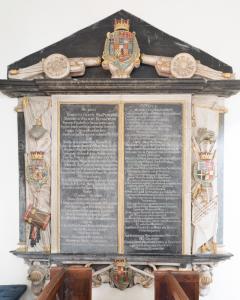
On 04 Feb 1698 Thomas Strode of Parnham (age 70) died. Monument in Church of St Mary, Beaminster [Map]. William and Mary. Marble with standing figure in wig, gown, side pilasters support cornice.
Thomas Strode of Parnham: In 1628 he was born to John Strode of Parnham and Anne Wyndham. On 01 Jul 1642 he matriculated Oxford University. On 01 Feb 1665 Thomas Strode of Parnham and Mary Adams were married. In 1677 he was appointed Serjeant at Law.
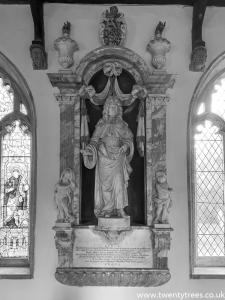
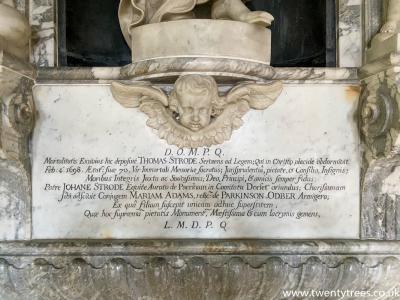
On 25 Jun 1766 Elizabeth Lygon (age 24) died of consumption. She was buried at St Andrew's Church, Wimpole [Map]. White marble inscription scroll flanked by putti beneath a shaped cornice enriched with torches and an urn, and with apron framing a cartouche of arms
Elizabeth Lygon: Around 1742 she was born to Reginald Pyndar aka Lygon of Madresfield in Worcestershire and Susannah Hamner. In 1762 John Yorke and she were married. He the son of Philip Yorke 1st Earl of Hardwicke and Margaret Cocks Countess Hardwicke.
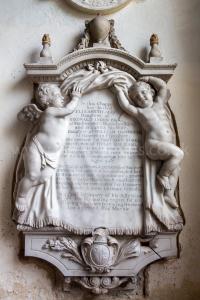
Dentilated Cornice
On 25 Jun 1601 Peregrine Bertie 13th Baron Willoughby (age 45) died at Berwick on Tweed [Map]. His son Robert Bertie 1st Earl Lindsey (age 18) succeeded 14th Baron Willoughby de Eresby. He was buried at St James' Church, Spilsby [Map].
On 15 Feb 1610 Catherine Bertie (age 15) died in childbirth. She was buried at St James' Church, Spilsby [Map].
Monument Elizabethan Period. Tall Sideboard Tomb with reclining hooded figure of Lady Katherine, daughter of Peregrine, with Chrisom Child in the crib at her feet. Above a standing figure of Peregrine Bertie 13th Baron Willoughby (age 45) in a niche, with strapwork embellishments, all supported on composite columns with a dentilated cornice.
Catherine Bertie: Around 1595 she was born to Peregrine Bertie 13th Baron Willoughby and Mary Vere Baroness Willoughby of Eresby. Sources are confused about her birth year stating she was born in 1610 and that she married in 1609. Date adjusted to around 1595 on the assumption she was married around twenty years of age. Her son died at six days old on 09 Feb 1610. Her father died in 1601. Sources also refer to her as Baroness Rockingham whereas she died some eleven years before her husband was created Baron Rockingham. In 1609 Lewis Watson 1st Baron Rockingham and she were married.
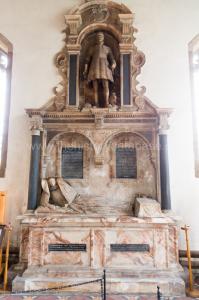
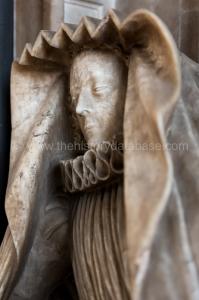
Moulded Cornice
After 29 Apr 1714. St Michael's Church, Stowe Nine Churches [Map]. Monument to Thomas Turner (deceased). Sculpted by Thomas Stayner (age 49). Baldachin. Drapery. Baroque. The figure on the left is Faith who holds a model of a circular church. The figure on the right is Thomas Turner (deceased). Segmental Pediment. Moulded Cornice.
Thomas Turner: In Sep 1645 he was born to Dean Thomas Turner and Margaret Windebank. Evelyn's Diary. 20 Dec 1685. Dr Turner, brother to yc Bp. of Ely, and sometime Tutor to my son, preach'd at Whitehall on 8 Mark 38, concerning ye submission of Christians to their persecutors, in were some passages indiscreete enough, considering yc time, and the rage of the inhumane French tyrant against the poore Protestants. On 29 Apr 1714 he died.
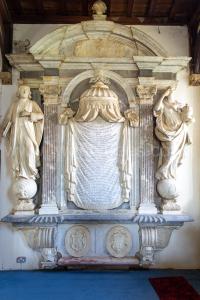
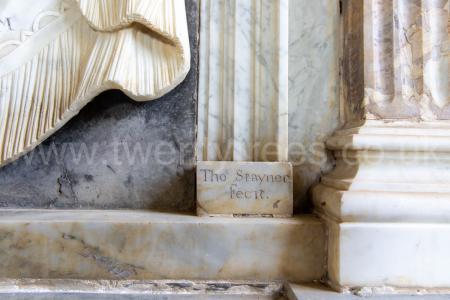
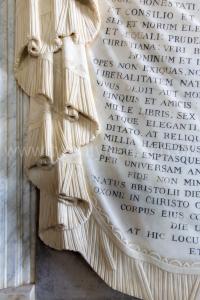
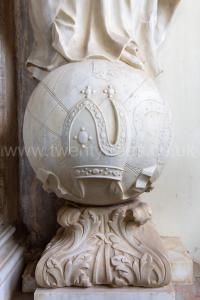
Scrolled Cornice
On 08 Feb 1809 Brownlow Bertie 5th Duke Ancaster and Kesteven (age 79) died without male issue at Grimsthorpe, South Kesteven. He was buried at St Mary's Church, Swinstead [Map] on 17 Feb 1809. Duke Ancaster and Kesteven, Marquess Lindsay extinct. His third cousin Albermarle Bertie 9th Earl Lindsey (age 64) succeeded 9th Earl Lindsey.
Sculpted by Richard Westmacott (age 33). A handsome white marble wall tablet in Grecian style depicting deceased and wife on a catafalque with mourning female figure, flanked by mother, children and angel. Above a scrolled cornice with Ducal coronet and palm. Beneath a rectangular inscription panel, flanked by scrolled brackets.
